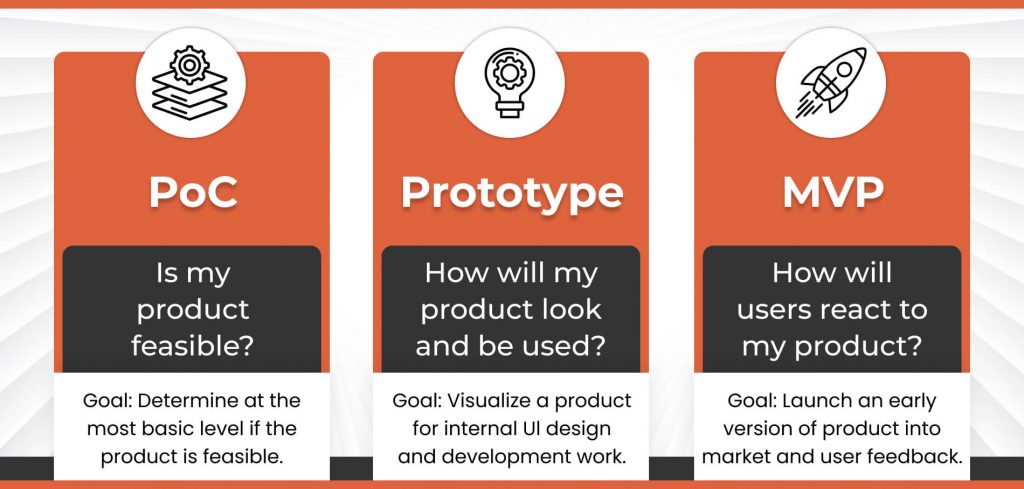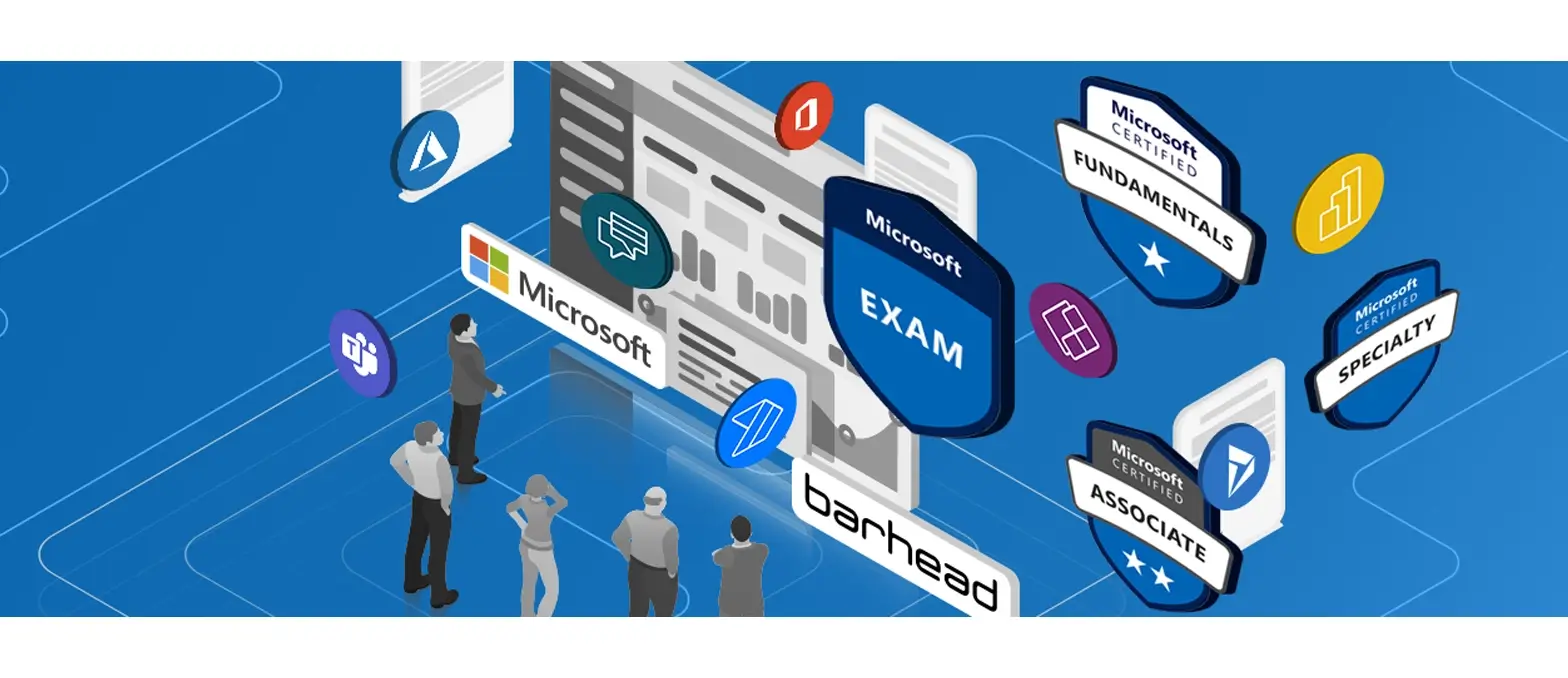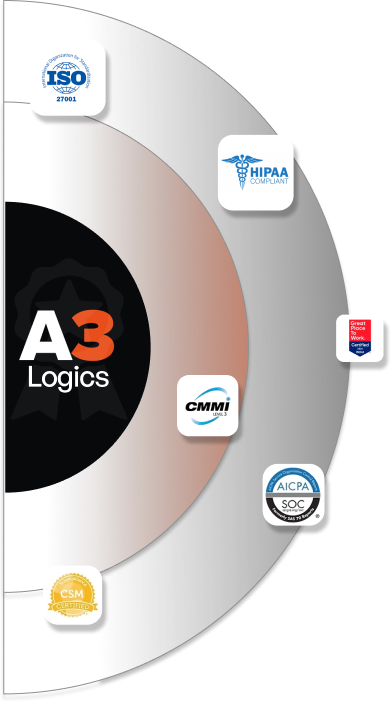Do you know why almost 66% of software development projects fail?
Businesses begin the software development process to complete the software project as soon as possible. However, the initial concept rarely meets the demands of today’s fast-evolving markets.
This is why software or any product should be technically feasible and able to solve real-world problems. That’s where the proof concept in software development comes into play. It helps identify risks, validate technology choices, and prevent budget-related mistakes early in the software development process.
In this post, we’ll explore the importance of having a Proof of Concept well before the software project enters the development phase.
Table of Contents
What Is Proof of Concept In Software Development?
Proof of Concept in software development is a verification methodology implemented in the initial stages of the software development life cycle. Creating a Proof of Concept aims to prove that the application, proposed system, or product will work in real life before the development phase begins.
Main Goals of Proof of Concept In Software Development
- Confirm that the software concept will yield the expected results and has the potential to be successful.
- To track issues at an early stage before investing in a full-fledged software development.
- To find out if it is technically possible to implement the suggested functions and solve the issues using the features intended.
- To provide the user base and stakeholders with a prototype that can give them a fair idea of what the software will do so that they can give feedback.
What PoC Does and What It Doesn’t
| What it Does | What it Doesn’t Do |
| Helps get actionable feedback from both end users and stakeholders Helps ascertain how interested the end user is in your software Validate the software idea or concept Test specific features of the software | Develop UI/ UX for software Create a minimal viable product or MVP Evaluate the technical feasibility of the project |
Different Types of PoC
There are different types of Proof of Concepts used in software development, each with its own significance. Here are the commonly used Proof of Concepts used in software development –
- Proof of Technology
Detects and provides resolution for any technical issues that may arise during the development phase of software products. It evaluates the various features of the software and notifies if they are compatible with each other. It also acts as a guideline for the development team, as they know where to start.
- Steel Thread
The steel thread looks at the design elements of a concept or product. It further investigates various software architectural patterns and profitability.
- Pilot
It is similar to the beta version or an MVP (Minimum Viable Product) where you can test the core features of the product with focus group and monitor user feedback and interest.
Must – Know PoC Statistics
- 53% of software projects use proof of concept to validate ideas before full-scale development.
- Companies that conduct PoCs are 20% more likely to achieve business goals and 30% more likely to launch successful new products and services.
- Proof of Concept allowed Walmart to reduce product traceability time from 7 days to 2.2 seconds.
- 75% of startups conduct at least one PoC before launching a product or service.
- Proof of Concept grants have a success rate between 32%-48%.
MVP VS Prototype Vs. PoC in Software Development

Source – Soft Kraft
Proof of Concept (PoC), Prototype, and MVP (Minimum Viable Product) are often used interchangeably, but each has its own significance. Here’s a comprehensive side-by-side comparison of each –
| Feature | PoC (Proof of Concept) | Prototype | MVP (Minimum Viable Product) |
| Purpose | Validate how feasible the idea or technology is. | Visualize and test design concepts | Release a basic functional product with the most important features |
| Focus | Assess if the concept is feasible and technically viable. | UX/UI and design validation | Release a functional version of the software for user feedback. |
| Development Stage | Early-stage, before development begins | Mid-stage; comes after PoC. Here, design and usability are explored. | Later stage after the prototype is made. It is ready for public use |
| Audience | Internal teams, investors, or stakeholders | Internal teams, early adopters, and testers | Real users and early customers |
| Functionality | Limited, often theoretical or experimental | Working model of the product | Fully functional with essential features |
| Time & Cost | Low to medium | Medium | Higher, as it requires a deployable product |
| Example | A machine learning model tested on sample data | A clickable wireframe of a mobile app | A working app with only the must-have features |
| Risk Level | High—may prove infeasible | Medium—design may need iterations | Lower—already validated but may still pivot |
Phases of An Efficient Proof of Concept In Software Development
- Justify the Need
Before developing the software, you should be clear about the issues your user base is facing. This makes sense since spending money and effort can only be justified if there are users facing the issue in the first place.
You could start by discovering the problems that a sufficient number of individuals are encountering. Furthermore, inquire about each stumbling block when communicating with users or stakeholders.
- Map Problems to Solutions and Get Feedback
Now that you have identified issues faced by a considerable number of users, you will find solutions for each in this phase. This phase involves a lot of brainstorming, as you won’t just be finding solutions to issues; you will also analyze each solution in terms of the cost involved, timeframe, competition, technology challenges, and many other factors.
After analyzing the solution, get feedback from users and stakeholders. Also, note everything that you’ll need to accomplish your goals—get an idea of the timeframe, assemble the development team, know your KPIs, etc.
- Prototype for User Testing
In this phase, you build a prototype that incorporates all the suggestions you received in the previous phase. It may not necessarily involve any coding, and it can be a simple design (like a wireframe or mockup) that gives end users and stakeholders a look and feel of the software.
Test the prototype alongside the users and stakeholders. At this stage, note the feedback you receive from your users.
- Developing a Minimum Viable Product (MVP)
Once you have an approved prototype, you can create an MVP (Minimum Viable Product). This version will have enough features to attract early adopters and validate the idea. It will have only the necessary features to address the main problems. That said, it should work flawlessly.
The aim of creating an MVP is to test the software with a larger group of people to get better feedback that can be used in software development.
- Develop a Plan of Action
At this stage, create a plan that considers all the conclusions and suggestions received in the previous phases. Use all the data you have collected previously to develop your software.
By leveraging the data and past suggestions, you can build a roadmap on which you can base your future development process, i.e., how you’ll develop the software’s final release.
- Integration Feasibility
The PoC examines the software’s ability to seamlessly integrate with an existing infrastructure, including any systems or critical software already in place. Even if the concept is innovative, the PoC ensures that it seamlessly connects with databases, workflows, and APIs to be truly useful.
- Performance & Scalability Testing
Performance testing determines how the software performs or remains responsive and stable under a certain workload. The software’s speed, reliability, robustness, and application size can be determined by executing performance tests.
Scalability testing analyzes how a system responds to changes in the number of simultaneous users. Unlike performance testing, which focuses on responsiveness, scalability testing focuses on how a system scales when faced with varied load levels.
- AI/ML Model Validation
In this phase, you evaluate the performance of the trained model on new or unseen data. You assess the effectiveness of the trained model using a testing dataset, which may or may not overlap with the data used for model training.
As an important phase in Proof of Concept in software development, AI/ML model validation ensures that the chosen model performs accurately and meets project goals. The phase also involves evaluating the accuracy, efficiency, and scalability of the model.
The Benefits of Creating a PoC in Software Development
In creating a PoC in software development, you are laying out on paper why your idea will succeed in the market. Here are the benefits of creating a Proof of Concept in software development –
- PoC in Software Development Saves Time And Money
One benefit of Proof of Concept when developing software is that it allows you to assess its commercial and technical viability. This helps to keep the costs in check right from the early stages of the project.
Only once you are confident in the project’s feasibility and its potential for successful implementation, you can proceed, and invest in hiring, onboarding, and initial development.
- Assist In Choosing The Right Tech Stack For Software Development
In software development, the Proof of Concept also demonstrates the idea’s viability from a technical standpoint. This means the development team can also determine the tech stack that will best suit the project requirements, especially considering the long-term view of the project.
- Assess Tech-Related Risks
PoC in software development can help determine how a technology will perform in the real world. It can also help uncover any notable issues and flaws in a proposed technology early in development.
Once encountered, the development team can resolve the flaws promptly before investing in the resources. They can also delve into other important aspects of technology, like whether it can meet future demands and needs and whether or not it is cost-effective.
- Convince Investors To Fund Your Startup’
If you plan to approach investors to fund your startup, a PoC can be a game-changer. It shows potential investors how feasible your idea is in a real-world scenario and whether it can solve users’ problems. All in all, it gives investors solid evidence of your software’s market potential.
A Proof of Concept in software development increases your credibility as it shows investors that by investing in your project, they’ll be entering a low-risk zone.
- PoC Can Fuel Stakeholders’ Confidence
A successful PoC reduces the chances of developing an incorrect product as you get early feedback from focus groups before developing the software. This can instill confidence in stakeholders, including partners, investors, and customers, assuring them that the chosen project has undergone extensive testing and shows promise.
- Have A Roadmap For Future Development
A PoC lays down a practical and clear roadmap for the next steps in the software development process. It lets teams tweak their approach, make any necessary adjustments, and go ahead with full-scale development while having complete clarity of what needs to be done.
If you have done PoC on the complex parts of your software project, you can expect your project to succeed.
Crucial Factors That Influence A PoC’s (Proof of Concept’s) Success In Software Development
Before you spend your time, money, and resources on the software development phase, here are some factors that should be considered when developing a Proof of Concept in software development –
- Assemble Your Technology Team
When you bring together individuals with skills relevant to the specific technology and project goals, you can rest assured that they will work in the right direction. With them, you can focus on validation and rapid prototyping instead of full-scale development.
If you don’t have the necessary skills or the team to build PoC, you can always engage the services of a custom software development company. They can help you assess feasibility, choose the right stack, and build a functional prototype efficiently.
A3Logics, for instance, is one of the best companies that provides custom software development services. It can help you with Proof of Concept in your software development journey.
- PoC Requirements – Your Goal
Define your goal to ensure that Proof of Concept requirements are met. You need to define what problems you intend to solve. Accordingly, you can channel your resources and technology to solve those issues.
Failure to define specific, measurable goals to evaluate PoC success criteria will eventually prevent it from succeeding.
- Define Project Expectations
Defining clear project expectations is one of the crucial factors influencing the success of Proof of Concept in software development. Here’s why: The Proof of Concept clearly defines what needs to be tested, how success will be measured, and its limitations while testing everything for the potential user base. This further clarifies the project’s scope, resources, and timeframe.
By defining these parameters, you can get feedback on what your target user base wants, which can then be used to streamline the development further.
- Monitor And Analyze Outcomes
One way to determine if your PoC is successful is if it matches your predefined success criteria and meets the objectives to determine its feasibility and value. For example, if you have built a healthcare appointment booking system, then it should be able to handle at least 1000 appointment requests per day without system crashes.
- Technical Limitations And Success
One factor that determines the success of a Proof of Concept is whether the tools or technologies chosen for PoC fully support the idea. While your concept may look impeccable on paper, you can only bring it to reality with scalable technologies with a proven track record.
To ensure that your PoC succeeds during software development, pilot with technologies that your team is already familiar with. This step will also help reduce any learning curves from time to time.
How to Develop Proof of Concept (PoC) for Software – The Process

Source – Soft Kraft
- Define The Problem/ Idea
In this step, you try to find an answer to a fundamental question: What do you wish to solve with your software?
The answer to this question will define your business idea. To find the answer, exhaustively research your target user base’s pain points, leaving nothing unexplored. You should have an idea of how to solve each of these pain points. You must also establish what your idea will accomplish in the long run.
- Identify and Set Goals
The goals are the metrics or benchmarks that will decide the success or failure of your project. For instance, if you wish to create an AI-powered medical diagnosis system, your goal might be to ensure that the AI model can correctly identify at least 85% of diseases based on the uploaded reports.
- Choose the Right Technology
Choosing the right technology lays the foundation for successful software. It involves selecting the best framework, programming language, databases, and tools to help bring your concept to life.
You should choose your tech stack carefully at this step, as this choice can later impact overall performance. When choosing the right tech stack, consider speed, compatibility, security, and maintenance.
- Build a Prototype
After the PoC successfully validates the idea’s feasibility, the next step is to create a prototype. This could be a wireframe, a mockup, or a simple sketch. A prototype consists of the basic envisioned features of the software and a minimal UI/ UX. It can be compared to the software’s skeleton, demonstrating the proposed workflow.
- Test and Gather Feedback
The goal of developing a prototype is to show a wireframe version of the software that demonstrates its basic functionality to the intended audience. Even though it mimics the user experience, it doesn’t have a backend functionality, and it is created to gather feedback from end users and stakeholders.
The step may also help you find features or help you make improvements that were missing from the software.
- Analyze Results
Evaluating the results is the most important step of PoC in software development. This is where you can find out if your proof of concept passed or not, if it was able to solve the pain points of your user base. Or if there is a scope for further improvement.
How Can A3Logics Help with PoC in Software Development?
Now that we have established how important proof of concept is in software development, you might want to have one for your business idea.
However, with multiple business priorities, you may not have the time or resources to develop a PoC. You might want a seasoned company to develop one. If that’s what you desire, A3Logics can be your partner.
Apart from providing custom software development services, we can also help you develop Proof of Concepts and Minimal Viable Products (MVP), showcasing the viability and potential benefits of your software concept. Our knowledgeable development team guarantees quick iteration and improvement, setting the stage for full-scale development.

Conclusion
Right before you start the full fledged development of the software and raising large amount of funds for it, a Proof of Concept (PoC) in software development helps you validate the core idea or concept behind a software. By checking the idea on various grounds you can unravel the risks before they place stumbling blocks in your development.
Apart from gauging the feasibility of the software concept, an effective PoC also helps the development team to estimate budgets accurately, check market needs and identify any scope of improvement in the performance. In this post, we have covered all such factors and we have also discussed how you can seek assistance from a custom software development company and get a PoC made.





